The best hunting strategy is to be about where the deer are in the dawn and dusk. The easiest way to achieve this is to hammock camp so that you stop hunting when it gets dark, sling your hammock and tarp between two trees and start again at first light. If you have to knock off your hunt so you’re not stumbling around in the dark getting out, you are missing the best time of day to hunt. Walking in the dark is also fraught with dangers best avoided – this is the voice of experience speaking!
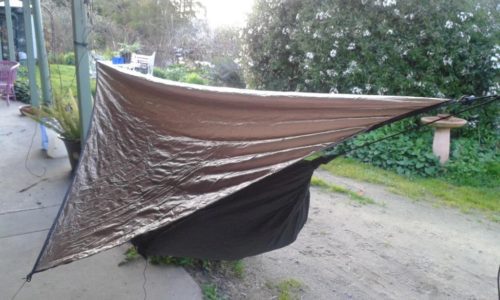
Many hunters either travel too light, or too heavy. The first can be overconfidence or youth, but once you get caught out overnight you may change your mind. At least do this: http://www.theultralighthiker.com/if-you-could-only-carry-two-things-in-the-bush-what-would-they-be/ Better yet though is to work out a lightweight kit so you plan to stay out overnight normally. Here are my thoughts about that from some years ago: http://www.theultralighthiker.com/hunting-daypack/ I think I would definitely opt for the Dyneema pack now, with the ability to tie some extra gear to the outside, eg: http://www.theultralighthiker.com/attaching-tie-downs-to-your-pack/
This post however is about planning to stay out overnight as your normal hunting procedure in order to optimise your crepuscular (love that word = twilight) success. A hammock and tarp can always be pitched between two trees no matter how steep the terrain, or how rough or wet the ground. This is worth remembering. I always carry a hammock in Fiordland for just this reason. I have slept dry and warm in my hammock with 6” (15cm) of water running underneath me and torrential rain streaming down (eg on Mt Baw Baw). If you do get caught out, here is an important survival idea: http://www.theultralighthiker.com/raincoat-shelter/
You can even pitch two hammocks under one tarp (to save weight). You have to boost the upper person in. Della and I have done this. You can guess who sleeps on top! It is also possible to double bunk: http://www.theultralighthiker.com/hammock-camping-double-bunking/ Here is a better way to double up. You can also pitch it as a ground camp if you want to and when the ground is flat. You can use a couple of sticks or hiking poles instead of trees. You will need a few more stakes and guys if you plan to do this where you use the hammock as a ground sheet.
You do not need to buy an expensive hammock or tarp. My first foray into hammock camping was many years ago when we were much more pressed for loose change than we are now. I purchased some 2oz/yd2 waterproof ripstop nylon from Spotlight (for about $7 a yard/metre) and away we went: We made a 7’ x 7’ (210 x 210 cm) tarp with gross grain tie outs at the four corners and half way down each side. We needed a few yards of (approx 2mm) Spectra cord so we could tie it to a tree and peg the other corners (and half way points – if needed) to the ground – so also some stakes (http://www.theultralighthiker.com/?s=stakes)
To construct the hammock we cut a 7’6” (225cm) length of the ripstop (a hammock needs to be approx 2’ or 60 cm longer than you are), single hemmed the edges and double hemmed the ends (ie with an extra line of stitching or two just in case). We used a pretty heavy duty polyester thread for this. Then all we needed was some approx 500 kg breaking strain Dyneema or Spectra cord for the suspension ropes. You want a fair length of this (say 10-12’ (3-3.6 metres) at each end so you can reach trees which are wider apart and get round thicker trees. Ideally you are looking for two trees approx 6” (15 cm) in diameter (or thicker) and 10-12’ (3-3.6 metres) apart.
There is a special way of tying the hammock to trees so that you can get the knot undone again! Be very attentive about this! As in the picture below you pass the cord around the tree, then under or over itself, back around the tree, then under or over itself again. Three times is enough. Then tie it off with a bow or whatever. Friction will ensure it won’t come undone. If you are worried about damaging the bark of the tree (this can be a problem) a few short lengths of stick pushed underneath the suspension rope will prevent this.
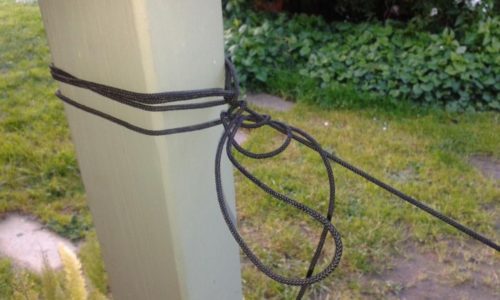
I slept out in this homemade hammock and tarp lots of times without any grief whatsoever. One night I was camped in the bush near Dargo, Vic with a couple of hunting mates who had a dome tent. It came in to rain. Then it came in to rain lots. After the first spell of rain my mates erected a tarp over their dome tent as it was leaking from the top. After the second lot of rain it was also leaking/flooding from the bottom. All their bedding became soaked. They ‘enjoyed’ a miserable night. Even with only a 7’ x 7’ tarp (and a lot of rain and wind!) I was completely dry and comfortable. That night I was just using a ¾ length self inflating Thermarest. It was a little short and my shoulders and arms were a little cold from where they compressed my sleeping bag’s insulation. I would use my Exped Synmat HL Winter M mat now. Live and learn:
I tried a number of solutions to this. First I moved up to an inflatable pad. My first was Big Agnes Ultralight ROM Insulated pad, still a wonderful (cheap) comfortable pad – highly recommended to anyone on a budget. Later I graduated to the lighter (but dearer) Thermarest Neoair range. Of course I now usually use mummy pads (for lightness) but a rectangular pad is much more suitable for hammock camping as the square ends help keep the hammock from compressing your sleeping bag at the shoulders and arms. You can also shove some closed cell foam in either side to reduce this negative.
I graduated to an Exped ‘Scout’ hammock (it was weight rated) which I reckon I slept in well over 200 times. It is starting to show some sign of wear and tear now but I was very heavy then (100kg) so it should last you a fair while. I also ‘graduated to a slightly larger and lighter tarp : an 8’ x 8’ (240 x 240 cm) cuben tarp made from .5oz/yd2 material which weighed less than 150 grams. Eventually I sewed a couple of ‘wings’ on it so it better suited ground camping (or when heavy weather was really pushing in low from one direction). This pushed its weight out to around 200 grams. I have used it dozens and dozens of times without any sign of wear and tear. It is a quite delicate fabric, so you have to be careful with it. Joe Valesko from Zpacks made it for me. You can see it on his web page here: http://www.zpacks.com/shelter/tarps.shtml and on mine here: http://www.theultralighthiker.com/hammocks/
The key to comfort sleeping in a hammock is to place your (inflatable) pillow underneath your knees. An empty wine cask would suffice.
Della and I both tried the Hennessy Hammocks which I admit are very comfortable. Probably no-one has done so much design work to improve the hammock as Tom Hennessy. Their products are also very well constructed and will give good service. We had two of the bottom entry hammocks (which are a neat idea). Della had no trouble entering through the bottom and positioning herself on her Thermarest Neoair pad for a wonderful night’s sleep. I found it much more difficult but I admit that was before my back operation and before I lost so much weight, so I will have to try again. (PS: And I did & it is now easy!)
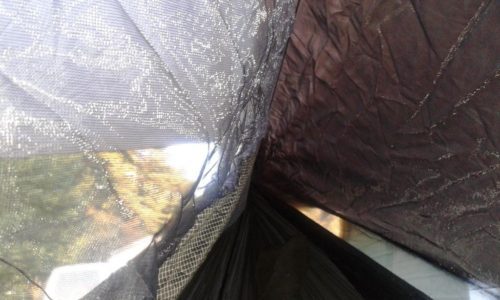
View from inside a Hennessy Hyperlite
If I was starting out now (and cashed up) I might buy an http://hennessyhammock.com/products/hyperlite-asym-zip which weighs 793 grams, but the bottom entry employs no zips and is so simple and elegant. You can use the optional Underpad: http://hennessyhammock.com/products/replacement-underpad-1-classic-expedition-backpacker-and-hyperlite 284 grams & Undercover http://hennessyhammock.com/products/replacement-zip-undercover-1 164 grams = 448 grams T = 1241 grams. I would probably just use my Thermarest Neoair Xlite Women’s pad http://www.cascadedesigns.com/therm-a-rest/mattresses/fast-and-light/womens-neoair-xlite/product @ 340 grams T = 1133 grams though a Regular rectangular Neoair pad will work better in a hammock.
The problem you have with cold shoulders in hammocks applies much less so with Hennessy’s because you lie much flatter and the material doesn’t compress your sleeping bag so much at the sides. I will try to get hold of one of his new ‘zip’ top loaders to review. Ours are both entered from below.
We both really like the wonderfully safe enclosed feel of their hammocks completely surrounded first by insect netting then by a cosy roof. You really feel that after you have gone to bed there is nothing to worry about until morning. Forget all those things which might slither or bite, or whether the rain do rain or the wind do blow! There are handy stowage points for your pocket gear along the fixed centre line – a Hennessy innovation which is what makes their hammocks so superbly comfortable. (You can add this to your home made hammocks though it is a Hennessy patent). The Hennessys also have some pretty neat ideas for stowing your hammock, for keeping it properly tensioned – even water collection using the covering tarp. It’s all very well thought out and neat! Their ‘Snakeskins’ quick storage solution makes set up a breeze, though it adds a little to the weight and is an optional extra.
NB: If you are ordering a hammock such as a Hennessy which normally uses ‘tree straps’ or ‘tree huggers’ as bark protection for soft barked trees which might be much more common in some places, you should realise that the standard suspension ropes might be too short for tying straight to trees such as you might normally do when hammock hunting in the Australian bush where damage to bark is not likely to become an issue. They do customisation. I would order a hammock with much longer suspension ropes rather than having to join ropes. Possibly even 4 metres on each end. This will also save you some weight. You can always cut off any excess if you never use it.
The key to quick and accurate setup of any hammock is to get the two suspension ropes of equal length and correct tension. First lay the hammock out on the ground so that one end of the hammock just touches one of the trees. Take the suspension rope out till it just touches the other tree, then halve the rope (ie the distance from the tree to the hammock). This point will be just where the knot goes up against the tree. Tie the rope off to the tree. Then go to the second tree and tie off the second rope to the correct tension. This is much easier with a Hennessy hammock or if you have a fixed centre line as the rope will be quite taut. Without the fixed centre line you need a certain amount of ‘hang’. Aficionados recommend approx 30 degrees. No doubt this is a matter of taste, but once you have worked out just the amount of ’hang’ you prefer you will be able to tie the hammock off in one go using this method.
The Hennessy hammock tarp just hooks on to the suspension rope with two Prussic knots (which is a great idea for easy tensioning of the tarp). If you are using some other tarp a loop of elastic at each end of the tarp will help to keep it tensioned during the night. The tarp needs to start out a little tauter than you might expect (likewise the hammock) as the two trees will bend in slightly when you enter the hammock. A catenary cut tarp will stay tensioned better than a diamond tarp.
The lightest hammock I have found is the Grand Trunk Nano hammock https://www.grandtrunk.com/products/nano-7-hammock which is claimed to carry 300lb (or 136 kg)! I reduced the weight of this hammock further by substituting dyneema suspension ropes so that it weighs 165 grams including the ropes. If you add a cuben tarp to this (136 grams) you have a hammock/shelter setup which weighs just 300 grams! These two items would also just about fit in your two back trouser pockets! I would use a ¾ length Neoair pad (260 grams) plus my Airbeam pad from my daypack to that to complete my shelter and mattress system. Of course (never satisfied) I plan to lighten this even further by making my tarp double as my raincoat. (See: http://www.theultralighthiker.com/hole-less-ponchoshelter/)
I have recently discovered the wonderful hummingbird hammocks http://www.theultralighthiker.com/a-hummingbird-in-the-hand/which are even lighter and possibly better – and come in a number of sizes. I took one to walk the Dusky Track in Fiordland in April 2017. It will accompany me on many more adventures.
One of the best features of a hammock is what a great seat it makes. When you have mastered the setup it will only take you 1-2 minutes till you have a really comfy dry seat out of the rain to eat your lunch. I have really appreciated this sometimes in Fiordland. Two can usually sit happily side by side (but don’t exceed the load limit!) and you can even boil the billy on an alcohol or bushbuddy type wood burner stove at your feet while you eat. It would also make a great platform for glassing a distant hillside or as a hunting stand where you await your chosen prey. You can even rug up warm and dry in your sleeping bag while you wait. Joe at Zpacks will even make the tarp in camo if you prefer!
You can warm your hammock with a fire (if you are careful). Either light the fire to the lee side of one of the suspension trees, or (utilising a stick) lift up one side of the tarp so that you can sit in your hammock in front of the fire. Two guys on that side will obviate this. I would keep the fire at least 6’ (1.8metres) away from the hammock.
Always stay away from large trees whenever you are camping. They sure can and do drop deadly branches. You need two trees about 6-8″ (15-20 cm) in diameter to tie your hammock to. They need to be 4-5 metres apart. It is surprisingly harder to find a pair of suitable trees than you would think! If the trees are too small they will bend inwards a bit too much – otherwise you can probably go down to about 3″ (7.5cm) in diameter. Your tarp will be a bit flappier is all. At least you are less likely to be killed by lightning if you are in a hammock (as you are not earthed)! Happy Hammocking!
If you have a bad back a hammock is definitely for you. Before my successful back operation (neurosurgery – never let an orthopaedic surgeon near your back!) I hung in our lounge room in my hammock for months so I could get a comfy and relatively pain free night’s sleep.
PS: You can hang two hammocks side by side from just two trees which then only needs one tarp for two people. The minimum weight for such an arrangement (for two) is approx 570 grams. See: http://www.theultralighthiker.com/simple-hammock-double-up/
Here are a couple of hammock tarp manufacturers:
http://www.zpacks.com/shelter/hammock_tarps.shtml (start at 136 grams!)
http://www.outdoorequipmentsupplier.com/maccat_tarps.php (inventor of the cat cut tarp)
And a couple of hammock manufacturers:
Hummingbird: https://hummingbirdhammocks.com
Hennessy: http://hennessyhammock.com
Speer: http://www.tttrailgear.com/brands/Speer-Hammocks.html (Ed’s book is worth a read)
Jacks: http://www.jacksrbetter.com
Exped: http://www.exped.com/international/en/product-category/hammocks/scout-hammock
An Aussie outfit: Tier Gear: http://www.tiergear.com.au
Happy Hammock Hunting!
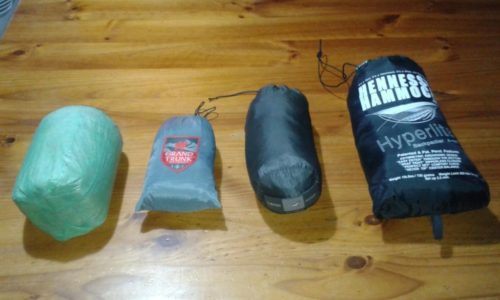
Left to Right: Zpacks 8′ x 8′ tarp (150 grams); Nano Hammock (165 grams); Exped Scout hammock (320 grams); Hennessy Hyperlite hammock – includes tarp (750 grams)
You can now make a hammock which weighs (well) under 150 grams including its suspension system! Given that you can also make a hammock tarp which weighs less than this including tie-outs and pegs, (so a total carry weight of sub 300 grams!) An Ultralight Hammock
My new tents/tarps double as hammock tarps or tents. See eg Silnylon Hammock Tent and The Grey Flyer.
Other hammock related posts:
http://www.theultralighthiker.com/simple-hammock-double-up/
http://www.theultralighthiker.com/no-cold-shoulder-spreader-hammock/
http://www.theultralighthiker.com/a-hummingbird-in-the-hand/
http://www.theultralighthiker.com/adjustable-hammock-ridgeline/
http://www.theultralighthiker.com/continuous-loop-another-great-hammock-idea/
http://www.theultralighthiker.com/whoopie-slings-what-a-great-idea/
http://www.theultralighthiker.com/side-insulation/
http://www.theultralighthiker.com/hammock-pad-extender/
http://www.theultralighthiker.com/diy-netless-hammock/
http://www.theultralighthiker.com/klymit-hammock-pad/
http://www.theultralighthiker.com/make-your-own-tarp-or-hammock/
http://www.theultralighthiker.com/hammock-camping-double-bunking/
http://www.theultralighthiker.com/hammock-hunting-till-dark/
http://www.theultralighthiker.com/all-in-one-hammock-tent-poncho-backpack-at-1-2-kg/
http://www.theultralighthiker.com/laybag/
http://www.theultralighthiker.com/all-you-ever-need-to-know-about-tarps/
http://www.theultralighthiker.com/tier-gear-catenary-cut-hex-tarp/
http://www.theultralighthiker.com/900th-post/
http://www.theultralighthiker.com/sleeping-pad-reinvented-big-agnes-q-core-slx/
http://www.theultralighthiker.com/modifyingshortening-hiking-mats/
http://www.theultralighthiker.com/catenary-cut-tarp/
http://www.theultralighthiker.com/thermarest-speedvalve/
http://www.theultralighthiker.com/hole-less-ponchoshelter/
http://www.theultralighthiker.com/hammocks/
http://www.theultralighthiker.com/hammock-camping/
http://www.theultralighthiker.com/the-ultralight-deer-hunter/
http://www.theultralighthiker.com/hunting-in-fiordland/
See also:
http://www.theultralighthiker.com/a-gorilla-in-the-bush/
http://www.theultralighthiker.com/hammock-hunting-till-dark/
http://www.theultralighthiker.com/no-sew-sandals/
http://www.theultralighthiker.com/gippsland-pack-rafting-routes/
http://www.theultralighthiker.com/you-take-the-high-road-and-ill-take-the-low/
http://www.theultralighthiker.com/wonnangatta-waterford-to-angusvale-day-one/
First Published 04/09/2016

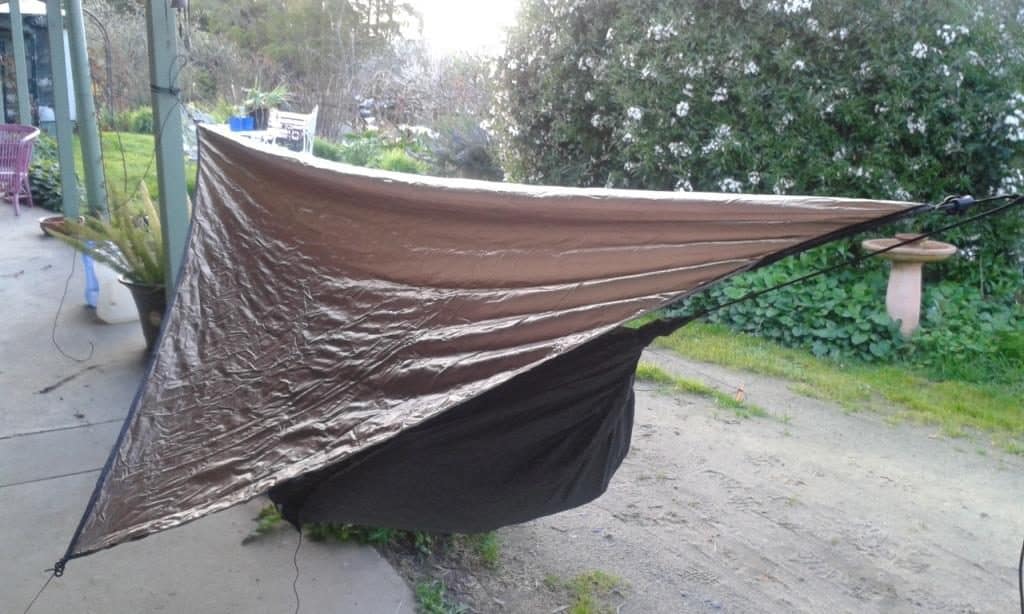
Hello! Good article. I was thinking of getting a Hennessy Hyperlite but i have read you need a ridgeline in a hammock to regulate the perfect amount of sag in your hammock. Does the Hyperlite include a ridgeline or is the bugnet the ridgeline?
Thanks Nick. You can just buy an adjustable ridgeline for a few dollars: http://www.theultralighthiker.com/adjustable-hammock-ridgeline/. I think all the Hennessys have a ridgeline. They are about twice as heavy as you need to go with a hammock set-up though, so you might want something simpler to save weight. Also, I usually want to have the option of sleeping on the ground as well. That is why I go with eg the Hummingbird or Nano and a tarp which can be used for ground camping as well. I have lots of other hammock posts which you should maybe read before parting with your hard-earned. And DIY will save you heaps!
Ok, didn’t know if the hennessys had a ridgeline. Do you have the hummingbird one+ or double? I guess you have a seperate bug net for the hammock.
I have all three sizes in the Hummingbird and a couple of the lightest Hennessys. The single is fine for one, two singles are better for a couple (http://www.theultralighthiker.com/simple-hammock-double-up/), but you can fit two in the mid size one in an emergency. I don’t use bug nets – just a Sea to Summit Nano head net, eg 11 grams: http://www.theultralighthiker.com/mozzie-nets/. I don’t see the point of anything else when you are asleep. Any other time you are just as likely to be outdoors anyway. I usually just use a single and this cuben tarp (http://www.theultralighthiker.com/hammock-camping-double-bunking/). With this system (under 350 grams) I can sleep on the ground or in the trees – and have a fire. Cheers, Steve.
Been reading your fantastic blog for a year now, you’ve really inspired me to get out and go for it! I’m super excited to take my old .303 up into the hills this July. I even have a heap of army webbing but after reading I think I’ll leave it at home!
I’ve just bought one of these:
https://www.anacondastores.com/camping-hiking/sleeping/hammocks/spinifex-laze-away-ii-nylon-hammock/p/BP90111557 And I have access to plenty of old sails and dyneema rigging for tarp etc
Love to hear your thoughts on the hammock, but either way thanks for writing this blog, and keep up the good work, it’s extremely motivating writing and your home made solutions are a breath of fresh air compared to a lot of the products being flogged by paid reviewers.
Thanks
john
Thanks John. Whoopie slings are great for rigging a hammock I think Tier Gear has instructions on how to make them out of Dyneema cord. I don’t know this particular hammock. I have a Hummingbird and a Nano which are very light – say around 150 grams. Alight 8′ x 8′ tarp makes this into a very light camping setup. There s certainly nothing wrong with the old .303. Can’t imagine why most hunters have moved over to more expensive options really. Happy hunting. Cheers, Steve.
Quick question about tree selection. Do you find any need to be concerned about Gumtree branches dropping, or tree danger?
Hi James, Good question. I will add this info to the post: Well, always stay away from large trees whenever you are camping. They sure can and do drop deadly branches. You need two trees about 6-8″ (15-20 cm) in diameter to tie your hammock to. They need to be 4-5 metres apart. It is surprisingly harder to find a pair of suitable trees than you would think! If the trees are too small they will bend inwards a bit too much – otherwise you can probably go down to about 3″ (7.5cm) in diameter. Your tarp will be a bit flappier is all. At least you are less likely to be killed by lightning if you are in a hammock (as you are not earthed)! Happy Hammocking! Cheers, Steve.
Great post. I am just getting into hammock camping and loving it. Whoopie slings are a great idea to keep the weight down and allow you to tension the hammock. My set up consists of a Hammock Bliss hammock with integrated fly net, a DD Tarp (2.4m x 3.4m for more protection at head/feet) with whoopee slings either end for suspension. I am contemplating a small gear hammock to hang underneath to keep my larger pieces of gear (bag etc) off the ground and dry.
Thanks Andrew. I think you could store your gear at each end of the hammock if you attached the hammock to the whoopie slings in the way that tier gear suggest so that you would have a carabiner at each end to clip gear to inside your hammock. This continuous loop method also puts much less stress and wear on the hammock. I just use a length of dyneema at each end and tie direct to the tree myself. Australian trees have very tough bark. If you are worried about hurting the tree you can always shove a few twigs between the rope and the tree. I do not use an insect net. I carry a Sea to Summit nano head net – since you will be in your sleeping bag this is all you need. I am going to buy one of Hummingbird’s ultralight hammocks (146 grams). I realise also that my hammock tarp could be lighter (approx 150 grams) but I often use it as a tent as well. Cheers, Steve.